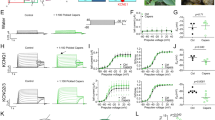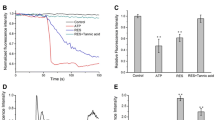Abstract
Quercetin, a representative flavonoid, is a compound of low molecular weight found in various colored plants and vegetables. Quercetin shows a wide range of neuropharmacological activities. In fact, quercetin naturally exists as monomer-(quercetin-3-O-rhamnoside) (Rham1), dimer-(Rutin), or trimer-glycosides [quercetin-3-(2G-rhamnosylrutinoside)] (Rham2) at carbon-3 in fruits and vegetables. The carbohydrate components are removed after ingestion into gastrointestinal systems. The role of the glycosides attached to quercetin in the regulation of γ-aminobutyric acid class C (GABAC) receptor channel activity has not been determined. In the present study, we examined the effects of quercetin glycosides on GABAC receptor channel activity by expressing human GABAC alone in Xenopus oocytes using a two-electrode voltage clamp technique and also compared the effects of quercetin glycosides with quercetin. We found that GABA-induced inward current (I GABA ) was inhibited by quercetin or quercetin glycosides. The inhibitory effects of quercetin and its glycosides on I GABA were concentration-dependent and reversible in the order of Rutin ≈ quercetin ≈ Rham 1 > Rham 2. The inhibitory effects of quercetin and its glycosides on I GABA were noncompetitive and membrane voltage-insensitive. These results indicate that quercetin and its glycosides regulate GABAC receptor channel activity through interaction with a different site from that of GABA, and that the number of carbohydrate attached to quercetin might play an important role in the regulation of GABAC receptor channel activity.




Similar content being viewed by others
References
Azevedo, M.I., A.F. Pereira, R.B. Nogueira, F.E. Rolim, G.A. Brito, D.V. Wong, R.C. Lima-Júnior, R. de Albuquerque Ribeiro, and M.L. Vale. 2013. The antioxidant effects of the flavonoids rutin and quercetin inhibit oxaliplatin-induced chronic painful peripheral neuropathy. Molecular Pain 9(1): 53.
Bormann, J., and A. Feigenspan. 1995. GABAC receptors. Trends in Neurosciences 18(12): 9–515.
Boue-Grabot, E., A. Taupignon, G. Tramu, and M. Garret. 2000. Molecular and electrophysiological evidence for a GABAc receptor in thyrotropin-secreting cells. Endocrinology 141: 1627–1632.
Chebib, M. 2004. GABAC receptor ion channels. Clinical and Experimental Pharmacology and Physiology 31: 800–804.
Enz, R., J.H. Brandstätter, H. Wässle, and J. Bormann. 1996. Immunocytochemical localization of the GABAc receptor rho subunits in the mammalian retina. Journal of Neuroscience 16(14): 90–4479.
Goutman, J.D., and D.J. Calvo. 2004. Studies on the mechanisms of action of picrotoxin, quercetin and pregnanolone at the GABA rho 1 receptor. British Journal of Pharmacology 141(4): 27–717.
Goutman, J.D., M.D. Waxemberg, F. Doñate-Oliver, P.E. Pomata, and D.J. Calvo. 2003. Flavonoid modulation of ionic currents mediated by GABAA and GABAC receptors. European Journal of Pharmacology 461(2–3): 79–87.
Griebel, G., G. Perrault, S. Tan, H. Schoemaker, and D.J. Sanger. 1999. Pharmacological studies on synthetic flavonoids: comparison with diazepam. Neuropharmacology 38(7): 77–965.
Harborne, J.B., and C.A. Williams. 2000. Advances in flavonoid research since 1992. Phytochemistry 55(6): 481–504.
Havsteen, B.H. 2002. The biochemistry and medical significance of the flavonoids. Pharmacology and Therapeutics 96(2–3): 67–202.
Jansen, A., M. Hoepfner, K.H. Herzig, E.O. Riecken, and H. Scherübl. 2000. GABA(C) receptors in neuroendocrine gut cells: a new GABA-binding site in the gut. Pflugers Archiv. European Journal of Physiology 441: 294–300.
Kambe, D., M. Kotani, M. Yoshimoto, S. Kaku, S. Chaki, and K. Honda. 2010. Effects of quercetin on the sleep–wake cycle in rats: involvement of gamma-aminobutyric acid receptor type A in regulation of rapid eye movement sleep. Brain Research 1330: 8–83.
Kandaswami, C., and E. Middleton Jr. 1994. Free radical scavenging and antioxidant activity of plant flavonoids. Advances in Experimental Medicine and Biology 66: 76–351.
Kyselova, Z., M. Stefek, and V. Bauer. 2004. Pharmacological prevention of diabetic cataract. Journal of Diabetes and Its Complications 18(2): 40–129.
Lee, B.H., S.M. Jeong, J.H. Lee, J.H. Kim, I.S. Yoon, J.H. Lee, S.H. Choi, S.M. Lee, C.G. Chang, H.C. Kim, Y. Han, H.D. Paik, Y. Kim, and S.Y. Nah. 2005. Quercetin inhibits the 5-hydroxytryptamine type 3 receptor-mediated ion current by interacting with pre-transmembrane domain I. Molecules and Cells 20(1): 69–73.
Lee, B.H., J.H. Lee, I.S. Yoon, J.H. Lee, S.H. Choi, M.K. Pyo, S.M. Jeong, W.S. Choi, T.J. Shin, S.M. Lee, H. Rhim, Y.S. Park, Y.S. Han, H.D. Paik, S.G. Cho, C.H. Kim, Y.H. Lim, and S.Y. Nah. 2007. Human glycine alpha1 receptor inhibition by quercetin is abolished or inversed by alpha267 mutations in transmembrane domain 2. Brain Research 1161: 1–10.
Lukasiewicz, P.D., and F.S. Werblin. 1994. A novel GABA receptor modulates synaptic transmission from bipolar to ganglion and amacrine cells in the tiger salamander retina. Journal of Neuroscience 14: 23–1213.
Macdonald, R.L., and R.W. Olsen. 1994. GABAA receptor channels. Annual Review of Neuroscience 17: 569–602.
Marder, M., H. Viola, C. Wasowski, C. Wolfman, P.G. Waterman, B.K. Cassels, J.G. Medina, and A.C. Paladini. 1996. 6-Bromoflavone, a high affinity ligand for the central benzodiazepine receptors is a member of a family of active flavonoids. Biochemical and Biophysical Research Communications 223(2): 9–384.
Medina, J.H., H. Viola, C. Wolfman, M. Marder, C. Wasowski, D. Calvo, and A.C. Paladini. 1997. Overview—flavonoids: a new family of benzodiazepine receptor ligands. Neurochemical Research 22(4): 25–419.
Miksicek, R.J. 1993. In situ localization of the estrogen receptor in living cells with the fluorescent phytoestrogen coumestrol. Journal of Histochemistry and Cytochemistry 41(6): 10–801.
Nilsson, E., and B. Eyrich. 1950. On treatment of barbiturate poisoning. Acta Medica Scandinavica 137(6): 381–389.
Oyama, Y., P.A. Fuchs, N. Katayama, and K. Noda. 1994. Myricetin and quercetin, the flavonoid constituents of Ginkgo biloba extract, greatly reduce oxidative metabolism in both resting and Ca2+-loaded brain neurons. Brain Research 635(1–2): 9–125.
Picq, M., S.L. Cheav, and A.F. Prigent. 1991. Effect of two flavonoid compounds on central nervous system. Analgesic activity. Life Sciences 49(26): 88–1979.
Polenzani, L., R.M. Woodward, and R. Miledi. 1991. Expression of mammalian gamma-aminobutyric acid receptors with distinct pharmacology in Xenopus oocytes. Proceedings of the National Academy of Sciences of the United States of America 88(10): 22–4318.
Pyo, M.K., Y.K. Koo, and H.S. Yun-Choi. 2002. Anti-platelet effect of the phenolic constituents isolated from the leaves of Magnolia obovata. Nat Prod Sci 8(4): 147–151.
Sine, S.M., and P. Taylor. 1982. Local anesthetics and histrionicotoxin are allosteric inhibitors of the acetylcholine receptor. Studies of clonal muscle cells. Journal of Biological Chemistry 257(14): 104–8106.
Speroni, E., and A. Minghetti. 1988. Neuropharmacological activity of extracts from Passiflora incarnata. Planta Medica 54(6): 91–488.
Stefek, M., and C. Karasu. 2011. Eye lens in aging and diabetes: effect of quercetin. Rejuvenation Res 14(5): 34–525.
Acknowledgments
This work was supported by the Basic Science Research Program (2011-0021144) and the Priority Research Centers Program through the National Research Foundation of Korea (NRF), which is funded by the Ministry of Education, Science, and Technology (2012-0006686) and by the BK21 plus project fund to S.-Y. Nah.
Author information
Authors and Affiliations
Corresponding author
Electronic supplementary material
Below is the link to the electronic supplementary material.
Rights and permissions
About this article
Cite this article
Kim, HJ., Lee, BH., Choi, SH. et al. Differential effects of quercetin glycosides on GABAC receptor channel activity. Arch. Pharm. Res. 38, 108–114 (2015). https://doi.org/10.1007/s12272-014-0409-2
Received:
Accepted:
Published:
Issue Date:
DOI: https://doi.org/10.1007/s12272-014-0409-2




